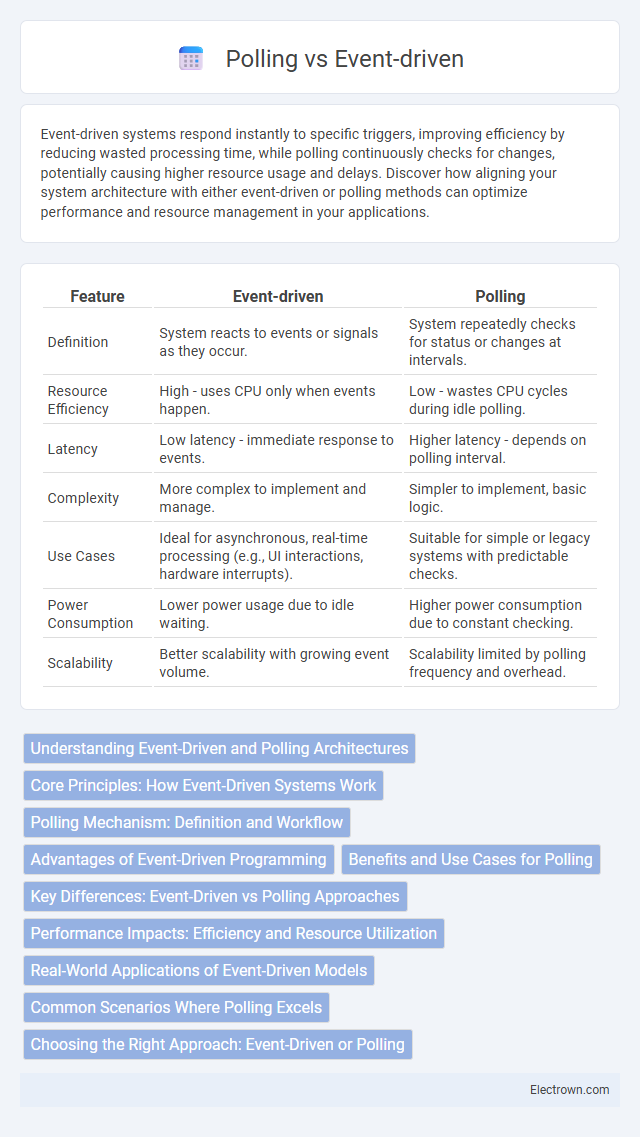Event-driven systems respond instantly to specific triggers, improving efficiency by reducing wasted processing time, while polling continuously checks for changes, potentially causing higher resource usage and delays. Discover how aligning your system architecture with either event-driven or polling methods can optimize performance and resource management in your applications.
Table of Comparison
| Feature | Event-driven | Polling |
|---|---|---|
| Definition | System reacts to events or signals as they occur. | System repeatedly checks for status or changes at intervals. |
| Resource Efficiency | High - uses CPU only when events happen. | Low - wastes CPU cycles during idle polling. |
| Latency | Low latency - immediate response to events. | Higher latency - depends on polling interval. |
| Complexity | More complex to implement and manage. | Simpler to implement, basic logic. |
| Use Cases | Ideal for asynchronous, real-time processing (e.g., UI interactions, hardware interrupts). | Suitable for simple or legacy systems with predictable checks. |
| Power Consumption | Lower power usage due to idle waiting. | Higher power consumption due to constant checking. |
| Scalability | Better scalability with growing event volume. | Scalability limited by polling frequency and overhead. |
Understanding Event-Driven and Polling Architectures
Event-driven architecture relies on asynchronous events to trigger processes, enabling efficient resource use by responding only when specific events occur. Polling architecture continuously checks the status of a resource or device at regular intervals, often leading to higher CPU usage and potential latency. Understanding these paradigms is crucial for designing responsive systems in IoT, user interfaces, and network communication.
Core Principles: How Event-Driven Systems Work
Event-driven systems operate by responding to specific events or signals generated by user actions, sensor outputs, or messages from other systems, triggering corresponding event handlers that process these inputs immediately. This approach enables asynchronous communication, allowing the system to remain idle until an event occurs, which optimizes resource utilization and enhances responsiveness. Core components include event emitters, event queues, and event listeners that work cohesively to detect, queue, and handle events in real-time.
Polling Mechanism: Definition and Workflow
Polling mechanism involves a system repeatedly checking the status of a device or resource at regular intervals to detect changes or events. This workflow continuously queries the target, consuming CPU resources and potentially causing latency if the polling frequency is too low or system overhead if too high. Polling is commonly used in simple hardware interfaces and legacy systems where event-driven interrupt capabilities are unavailable.
Advantages of Event-Driven Programming
Event-driven programming offers increased efficiency by responding immediately to user actions or system events, reducing unnecessary CPU usage compared to continuous polling. This approach enhances application responsiveness and scalability, as event handlers execute only when triggered, allowing better resource allocation. Event-driven models also simplify asynchronous processing, improving the management of real-time data and interactive user interfaces.
Benefits and Use Cases for Polling
Polling offers simplicity and predictability by repeatedly checking the status of a resource or event at fixed intervals, making it suitable for scenarios where events occur at regular, known timings. It is beneficial in systems with low event frequency or limited support for asynchronous communication, such as legacy hardware interfaces or simple sensor networks. Polling enables controlled resource usage and easier debugging due to its straightforward execution flow, despite potential latency and inefficiency in high-frequency event environments.
Key Differences: Event-Driven vs Polling Approaches
Event-driven systems rely on asynchronous notifications triggered by specific events, enabling efficient resource usage and real-time responsiveness, whereas polling continuously checks the status at regular intervals, often resulting in higher CPU usage and latency. Event-driven models excel in scenarios with unpredictable or sporadic events, while polling is simpler but less efficient, suitable for predictable, frequent checks. The choice impacts system performance, power consumption, and scalability, with event-driven approaches favored in modern, event-intensive applications.
Performance Impacts: Efficiency and Resource Utilization
Event-driven architectures maximize performance by reacting to specific events only when they occur, significantly reducing CPU usage and latency compared to polling methods. Polling consumes more resources as it continuously checks for state changes regardless of activity, leading to inefficient CPU cycles and increased power consumption. Optimizing for efficiency in real-time systems favors event-driven models, which allocate resources dynamically and minimize unnecessary processing overhead.
Real-World Applications of Event-Driven Models
Event-driven models are widely utilized in user interface design, where systems react instantly to user inputs such as clicks or keystrokes, enhancing responsiveness and efficiency. In IoT devices and sensor networks, event-driven architectures enable real-time processing by triggering actions only when specific conditions occur, reducing power consumption and bandwidth use. High-frequency trading platforms also rely on event-driven systems to rapidly respond to market data events, ensuring timely execution of trades and competitive advantage.
Common Scenarios Where Polling Excels
Polling excels in scenarios requiring regular status checks where event notifications are unavailable or unreliable, such as hardware device status monitoring or legacy system integrations. It suits applications needing fixed interval data retrieval, like periodic sensor data collection in IoT systems. Polling also works well in environments with simple protocols lacking event-driven capabilities, ensuring consistent and predictable data access.
Choosing the Right Approach: Event-Driven or Polling
Choosing between event-driven and polling approaches depends on application requirements such as responsiveness, system resources, and complexity. Event-driven systems offer efficient real-time processing and reduced CPU usage by reacting only to specific events, making them ideal for applications like UI interactions or network servers. Polling might be simpler to implement but can lead to unnecessary resource consumption and latency, so it suits environments where event detection cannot be easily implemented or predictable periodic checks are sufficient.
Event-driven vs Polling Infographic

 electrown.com
electrown.com